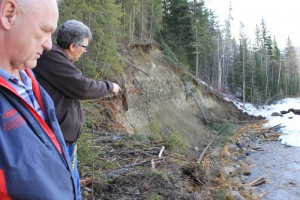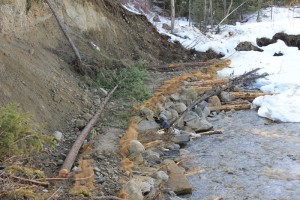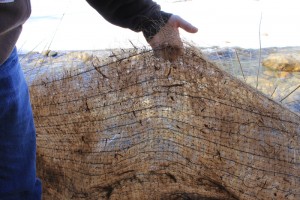
Mike Wallis of Wallis Environmental Aquatics is a registered professional biologist who has been restoring river banks in BC for over 20 years. On April 11 he and Bruce Wilkinson of the Swift Creek Restoration Society took the media on a tour of one of the creek bank restoration to show us what was done and how it will help – and how it is one part of a whole watershed management plan.
Severe spring run-offs in June 2012 caused the collapse of two banks upstream from the Valemount’s water intake which affected the village’s water supply, as well as damaging salmon spawning areas downstream. The high water and debris washed away areas of gravel the salmon need for laying eggs, especially near George Hicks Park, which is a big tourism draw to the area. The restoration work will hopefully provide more spawning grounds for the salmon, and help protect the village’s water supply, as well as protecting property values along the affected banks.
Wallis and Wilkinson took us up Carl Hammann’s driveway, which they used to access one of the banks that collapsed in the extreme freshet in June 2012. From there we looked down on the structure Wallis built along the edge of Swift Creek, including thousands of willow branches layered between rock, various types of cloth, and tree root wads. The willows are pacific willow, harvested a few weeks ago in the North Shuswap while still dormant. Wallis says they’ve been kept dormant on Hammann’s property for two weeks, then planted in the layers of the bank, and Wallis says they should start to bud in the next few weeks. Even if they don’t grow, he says they give a little bit of structure to the bank.

Photo: Korie Marshall
From the bottom, Wallis explains the structure is made up of rock anchors, logs, layers of fabric, all seeded over with grass seed, and a trench at the back.
“The rock points – to me they are very apparent. They are subtle to some people, but I know what is installed underneath.” Wallis says there are like teeth, with the tip sticking out, more or less, depending on how aggressive you want to be with the creek. There are also logs at the lower, more curved end of the section, anchored by rocks and sticking out a precise amount and at a precise angle. At the very end of the curve there is no structure, on purpose.
“We are prepared to sacrifice part of that bank and let the river take it out if it wants to, rather than pound the right hand bank out,” says Wallis. He says if they build up the entire corner, the water will tend to “rocket” across the creek, pounding the opposite bank, which could damage the recently restored riprap levee (the lower part of the Swift Creek Trail follows along this levee).
He says the various layers of fabric will help trap fine particles that may wash down the bank, and keep rain from washing material out until the whole structure sets. The layers of fabric will decompose at various rates, and within a few years, the coco matting with biodegradable nylon threads will disappear. The burlap on the top layers will disappear quicker, to hopefully be replaced by grass and other plants, and the black landscape fabric near the bottom will last the longest.

Photo: Korie Marshall
Winter is the best time to do this sort of work, says Wallis, because the ground is frozen, water is low, and plants are dormant. He says timing can be critical, and he is relieved to have gotten the work done before the warm weather and rain started.
“Getting the funding was the biggest challenge,” says Wallis, but now that the restoration work is started, every other application for Swift Creek will have a better chance. A large part of the funding came from the federal Recreational Fisheries Conservation Partnerships Program – Wallis says it was the only approved application on the program’s first intake.
Funding support also came from the Simpcw First Nation, Columbia Basin Trust, Kinder Morgan, Adventure Management (cash and in-kind), Wallis Environmental Aquatics (in-kind), the Village of Valemount, and the BC Cattlemen’s Association’s Farmland-Riparian Interface Stewardship Program. Wallis says help and support from local contractors and businesses was invaluable, including Jerry Plummer for the rock and wood, Doug Jensen and Monashee Towing for trucking, Big Iron Transport for lowbedding, Denis Nordli for plowing, Ken Abernathy and Lordco for service and parts, and the Ramada for accommodation. Wilkinson says the Simpcw have been involved with the project from the start, and are bringing an educational and cultural piece to the schools in the next couple of weeks.
Wilkinson says this is the beginning of a management plan for the entire watershed. “My goal is fish habitat and we have a lot more sites downstream we can improve,” he says, but it is part of a bigger picture of how to manage the watershed, not just for fish, but for water supply, property values, and recreation values.



